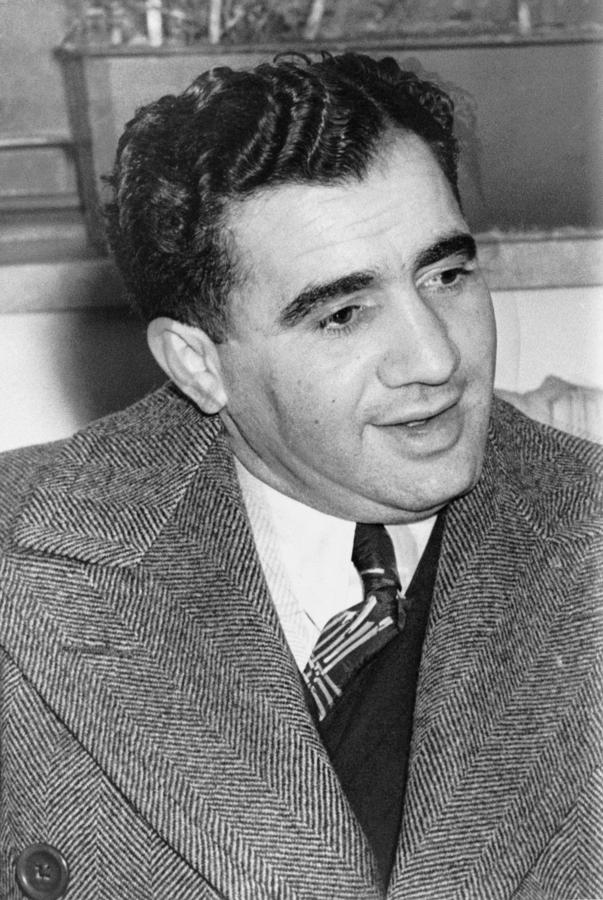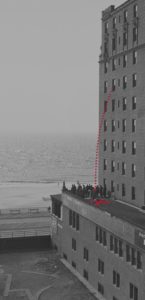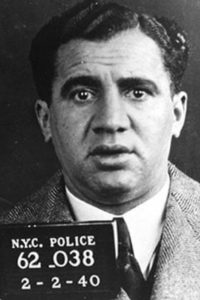Abe ‘Kid Twist’ Reles: No. 2 on list of Top 5 most notorious Mob hitmen
Key member of New York’s Murder Inc. committed at least 11 murders, and possibly many more

In this second installment in our series on the Top 5 most notorious Mob hitmen, we move from the Chicago bootlegging wars of the 1920s to the following decade, when a business approach to contract murder emerged in New York City.
Our selections are limited and the methodology subjective. The richness of the stories, the amount of dependable research material and how the individuals fit into the greater context of their times mattered more to us than the number of victims they chalked up.
The Top 5 are: “Machine Gun” Jack McGurn, Abe “Kid Twist” Reles, Roy DeMeo, Joe “The Animal” Barboza and Giovanni Brusca.
The Half Moon mystery
Early in the morning on November 12, 1941, former Brooklyn hitman Abe Reles was still alive in his room on the sixth floor of the Half Moon Hotel overlooking the beach at Coney Island, New York. Other rooms on the sixth floor housed three other ex-hitmen, who, like Reles, were under heavy police guard in protective custody while they provided details of Mob hits conducted at the behest of the national crime syndicate throughout the 1930s.

Reles, at the request of Mob bosses Louis “Lepke” Buchalter and Albert Anastasia, killed at least 11 people, and perhaps up to 30, while a member of the so-called Murder Inc. team of hit men created in 1934. But he knew about many more. His detailed information would help the Brooklyn District Attorney’s Office to eventually solve 85 gangland murders, including the killing of Mob boss Dutch Schultz in 1935. In the process, he exposed contract murders ordered by leaders of American crime groups in New York and across the country. Brooklyn District Attorney William O’Dwyer even flew Reles out to California to testify before a grand jury
Now, Reles and three fellow murderers awaited the DA’s next move in their hotel rooms, known by police as “the Squealers’ Suite.”
What actually happened that morning in Reles’ room at the Half Moon remains a mystery. The evidence at the scene indicated that for some unknown reason, Reles attempted to escape out the window, perhaps to play a joke on police, or to see his pregnant wife and child. Only hours earlier, his wife, Rose, had stormed out of his room after witnesses heard the two arguing loudly. He may have heard that the room below his was vacant — the hotel’s front desk received a call that night from an unidentified man asking if it was.
Reles apparently tied two bedsheets together and on one end tied a four-foot-long insulated electrical cord, then affixed the cord to the radiator, intending to lower himself through the window of the room beneath his. Someone had lowered the screen of that window by about half a foot. Police later noticed marks on the radiator, perhaps from the rubbing of the cord. Reles appeared to have made it to the ledge outside his window — police would link scuffmarks on his shoes to scratches on the ledge. But he did a lousy job fastening the wire to the radiator. The wire gave way, and he plunged four stories, in a sitting position, onto a roof extension below, shattering his spine.
At the time, people had heard Reles was to testify for Assistant District Attorney Burton Turkus against Buchalter, charged with first-degree murder, but Turkus had in fact decided not to call Reles.
Reles’ death shocked police, who had posted five detectives on the sixth floor for round-the-clock protection. (In the 1950s, some of the detectives finally admitted to sleeping on duty without making regular checks on Reles.) The press reported on rumors that Reles had tried to slip out of his room and escape to access a hidden cache of about $60,000. Rose, Reles’ wife, told police she knew nothing about the escape attempt and that their heated discussion hours before concerned only “general matters.” Meanwhile, an autopsy found that Reles suffered from a chronic condition of cysts on the lungs that simulated cancer, making those afflicted believe they might have cancer. Could that have made him more desperate to escape?
There’s no telling how many more murderers Reles would have helped Brooklyn District Attorney O’Dwyer convict if he had lived. By 1940, when the jailed Reles agreed to cooperate with the grand jury, Murder Inc.’s well-organized syndicate, centered in Brooklyn’s dangerous Brownsville district, had killed an estimated 1,000 people in all of about six years. Things had changed for Reles by then. His wife had given birth to their first child six years before and was pregnant with another.
Becoming a canary
While in his cell at New York’s miserable Tombs jail under indictment for murder in March 1940, Reles learned of a local hitman he knew who turned informant on a contract murder. He wrote a letter to Rose asking her to approach Assistant DA Turkus’ office for a way out. When she got there, she told Turkus she wanted “to save my husband from the electric chair. My baby is coming in June!”
Thus started negotiations with Reles to provide corroborating testimony damning some of his fellow Murder Inc. members. Reles consented to furnish information and testimony in exchange for immunity from prosecution. The arrangement meant he could not be prosecuted for information on murders he described to the grand jury. But prosecutors reserved the right to prosecute him for other killings if they had both evidence and eyewitnesses. Reles the “canary” was about to sing.
Murder Inc. began in the early 1930s, when New York’s five organized crime families instituted an enforcement wing based in Brownsville, Brooklyn to take care of hit targets, a stable of hitmen skilled in shootings, strangulations and other methods of murder. As law-abiding people struggled to go about their business, Brownsville’s street hoods, controlled by Manhattan bosses, accepted contract murders and worked the rackets – loansharking, bookmaking, policy gambling, prostitution, labor racketeering and extortion of shopkeepers.
Some of the targets were potential witnesses — O’Dwyer said that Murder Inc. had killed seven of 11 witnesses as New York District Attorney Thomas Dewey investigated hit factory leaders Buchalter and Jacob “Gurrah” Shapiro in the late ’30s. Buchalter, while in hiding, got Reles and his gang to rub out some of the witnesses readied to testify about dozens of murders “Lepke” had directed.
Buchalter’s hitmen included Martin “Buggsy” Goldstein, Harry “Pittsburgh Phil” Strauss, Harry “Happy” Maione, Abe “Pretty” Levine, Albert Tannebaum, Frank “The Dasher” Abbandando, Louis Capone and Charles Workman. Buchalter paid the killers as little as $35 a week to start.
When Reles began singing for prosecutors, it not only took down the killer corporation. His testimony in court cases also would send Buchalter, Strauss, Maione and Abbandando to die in the electric chair. Other Mob canaries followed Reles and started to cooperate.
Brooklyn street thug
Born in Brooklyn in 1906 and raised in Brownsville, Reles as a kid was sent to reform school at 13, harassed pushcart salesmen and progressed to extortionist at age 15. He nicknamed himself after the violent Jewish gangster Max “Kid Twist” Zweifach, who at 24 bossed New York’s Eastman gang before a mobster clipped him at Coney Island in 1908. Reles, tough and cunning, though just 5 feet 2 inches tall, had served four terms in prison by 1927. He was arrested for murder for the first time in 1930 (he beat the charge) when he launched his own Brownsville gang. He beat up store owners for kickbacks, ran $6-for-$5 street loans, ran bookmaking rings and pimped out young women. A judge once dubbed him as “more violent than [John] Dillinger.”

For Reles to move up to running his own squad in Brownsville, he had to get past the toughs who ruled the streets at the time, the vicious Shapiro brothers, Meyer and Irv. In 1930, as Reles would tell it, Meyer Shapiro kidnapped, beat up and raped Reles’ young girlfriend to intimidate him. Intent on revenge, Reles and his men initially proved ill-suited to take out Meyer. Reles’ less-than-competent shooters made 18 failed attempts until finally succeeding in killing both brothers in 1931.
Turkus and Sid Feder, in their 1951 book Murder, Inc., described Reles as “Brooklyn’s Public Enemy No. 1 from 1931, when he climbed to the top of the crew of killers, until he walked into the police station in 1940.”
“He was the most virulent and dynamic agent of the Mob,” the authors wrote. “He had a speech defect that was, incongruously, almost a lisp, and peculiar kind of walk that always made him look as if he were trying to kick his shoes off.”
In 1931, the year Charles “Lucky” Luciano started the Commission, Brooklyn Mob chief Albert Anastasia carried a murder order to his Brownsville lieutenant Louis Capone, who assigned the hit to the young, street-famous Reles. As Reles recalled later, after driving to the intended victim’s residence, “Louis points to the house, and tells me what room this bum lives in. I go in and shoot the guy five times. One of the slugs goes in the back of his head and takes one of his eyes out. After that I do a lot of jobs for Louis when he tells me. … Louis was always very nice to me.” Reles once said that beyond being paid for it, “When you kill, it’s a duty.”
Anastasia appointed Louis Capone (no relation to Chicago’s Al) as his contact to pass on instructions for the latest hit jobs to the Brownville gang. Reles and fellow hitman Happy Maione disliked each other but worked in unison on killings for Anastasia, with Capone keeping them in line. Meanwhile, on the side, Reles, Maione and others managed pieces of local bookmaking, crap games and loansharking. For a while, Reles and his fellow killers hung out at a 24-hour candy store in Brownsville, the Midnight Rose, the site of at least one backroom murder.
Newspapers pegged Kid Twist as the head of the “Reles Mob” by 1935 when he was 28 years old. Reporters also referred to him as the “vice president” of Murder Inc. His top hitmen were Goldstein and the kill-crazed Strauss. Reles had his torpedoes and wheelmen rehearse their movements to make hits come as close to flawless as could be. His standing spread, and the top hoodlums in New York asked him to take contract hits outside Brooklyn. His knowledge of those responsible for hits, such as Mendy Weiss’ role in the 1935 murder of Dutch Schultz, expanded as well. His incredible recall of details of scores of unsolved killings would be of great benefit for the Brooklyn District Attorney’s Office. Reles would, as no one before, expose the national crime syndicate covering Chicago, Denver, St. Louis, Kansas City and other cities that requested contract killings from Buchalter and Anastasia.
“I can tell you about fifty guys that got hit,” Reles promised. “I was on the inside. I don’t want to brag, but …”
Effective witness
The DA put Kid Twist on the witness stand in three trials of Murder Inc.’s so-called “cash and bury killers.” First, at the trial for co-defendants Maione and Abbandando, Reles acknowledged his complicity with the two men in the murder of George Rudnick, a suspected tattler stabbed 54 times with an icepick and smashed over the head with a meat cleaver in a garage in Brooklyn in 1937. Buchalter, prosecutors said, bade his hitmen to kill the low-level hood Rudnick as a warning to others tempted to sing. To make it into the newspapers, Buchalter had them set a note on the bloodied body, reading: “Thanks for the information. Please call on me again,” with the forged signature of Thomas Dewey, New York’s district attorney. Reles’ testimony sealed the case, and Maione and Abbandando were electrocuted at Sing Sing state prison in 1942.
Reles then testified in the trial that doomed his former crime partners Goldstein and Strauss. He described how he helped both guys stab and asphyxiate Irving “Puggy” Feinstein — at the home of Reles’ own mother — then light the body on fire. They did the job at the request of top-level syndicate loansharks. Convicted and sentenced to death, both men died in the chair at Sing Sing in 1941.
Meanwhile, amid the chaos Reles help stoke in gangland New York, the big fish Buchalter surrendered to authorities. His contrition didn’t save him from a murder conviction and death sentence enforced in the chair at Sing Sing in 1944. Meanwhile, Brooklyn DA O’Dwyer suspiciously let the other big fish fingered by Reles for ordering murders on Brooklyn’s waterfront and elsewhere — Anastasia — get away without charges. (Anastasia would die at the hands of hitmen in 1957.)
Unlike the key Murder Inc. cohorts he implicated, Reles escaped a trip to the electric chair. He may have tried to escape other troubles, languishing with a lung disease for a year and a half in guarded hotels, knowing there was a price on his head. Informants told O’Dwyer that the syndicate had tapped infamous torpedo Benjamin “Bugsy” Siegel, then living in Los Angeles, to coordinate a planned hit on Reles.
Right after Reles died, O’Dwyer confirmed he had received proof that three hitmen from California had been sent to New York to watch for and, if the moment arose, aim a rifle to kill Reles and two other Mob songbirds at the Half Moon Hotel.
At Reles’ gravesite, as a digger shoveled dirt, people present were surprised when a small creature emerged and ran across the grass. The sight encouraged one onlooker, not likely a mourner, to crack: “That’s a gopher. The rat is in the grave.”
Feedback or questions? Email blog@themobmuseum.org





